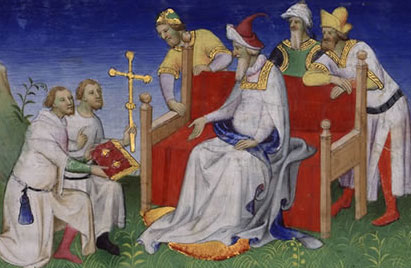
Khubilai Khan Greeting the Polo Brothers (detail)
Livre des merveilles, Bibliothèque nationale de France, Paris
The Mongol Era brought about the first instances of direct contact between Europe and Mongol-ruled China.
The Mongol attacks on Hungary and Poland in 1241 had alerted the Europeans to the power of the Mongols and so frightened them that, in 1245, the Pope in Rome called an Ecumenical Council to deliberate on a response to the Mongols. Two Franciscan missionaries were eventually dispatched to the East.
The first, who left Europe in 1245, was John of Plano Carpini, and the second was William of Rubruck, who traveled through the Mongol domains during 1253-1255. Both sought to achieve a kind of rapprochement with the Mongols, attempting to deter them from further attacks and invasions on Europe, as well as seeking to convert them to Christianity.
The Europeans had received information that the Mongols had a leader, named "Prester John," who had converted to Christianity. They also assumed that many of the Mongols already were Christians. In fact, some Mongol women, including Chinggis Khan's own mother, had converted to a heretical form of Christianity known as Nestorian Christianity. The Nestorian sect had been banned from Europe from around the 5th Century C.E., but had first spread to West Asia and then reached all the way to East Asia. But the idea that the Mongols could be converted to Christianity was an illusion at best.
Nonetheless, John of Plano Carpini and William of Rubruck were greeted cordially at the Mongol courts. Though they succeeded in neither their religious nor diplomatic missions, they were able to bring back the first accurate accounts of the Mongols.